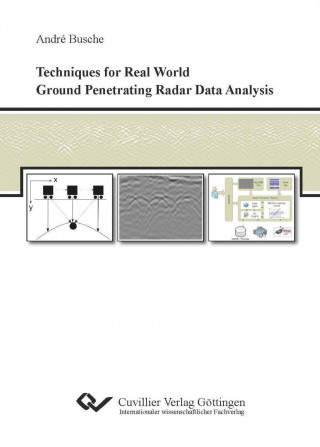
Doručení
Nákupní rádce





Nehodí se? Vůbec nevadí! U nás můžete do 30 dní vrátit
 Dárkový poukaz
V libovolné hodnotě
Dárkový poukaz
V libovolné hodnotě
S dárkovým poukazem nešlápnete vedle. Obdarovaný si za dárkový poukaz může vybrat cokoliv z naší nabídky.
Techniques for Real World Ground Penetrating Radar Data Analysis
 Angličtina
Angličtina
 119 b
119 b
30 dní na vrácení zboží
Mohlo by vás také zajímat


AbstractGround Penetrating Radar (GPR) Data Analysis deals with the problem of shallow subsurface imaging, which is motivated by the daily work of engineers, \eg those of municipalities.The concrete problem tackled in this thesis is motivated by the fact, that, at least in Germany, municipalities have knowledge about the existence of supply lines such as gas and water pipelines to cross and follow urban streets, while their actual position is often uncertain.The consequences are obvious:once a street undergoes maintenance works, pipes are easily broken.This also causes heavy problems to residents who are cut off from some supplies for a period of time.This thesis approaches a solution to the object detection problem in GPR data by means of (semi-)automated data analysis techniques, using Machine Learning methods.The problem is treated as a specialized problem for object detection in image data.In this application context, it is possible to integrate certain background knowledge and processing techniques in well-known Machine Learning methods.The thesis formalizes the problem first.A technical framework for the analysis of Complex Engineering Raw Data - CERD -, as a generalization of our current data at hand, will be used for all analysis methods developed.From a thorough data analysis, it becomes clear that our data labels are unsuitable for directly applying supervised Machine Learning methods.Therefore, we will be obtaining suitable ground truth data by semi-manually labeling more than 700 images by hand.The second part of the thesis presents both, supervised and unsupervised Machine Learning techniques for the detection of buried object locations.Techniques are introduced within the general context of object detection techniques within image data.The integration of geometrical background knowledge is shown to be feasible in all methods developed.This thesis will contribute in the followings:*The methodology and suitability of high-quality ground truth data for GPR data analysis is presented.*A conceptual framework along with its technical framework for the analysis of CERD is presented.*Intuitive, state of the art analysis methods for the interpretation of GPR data are presented, discussed, and evaluated.ZusammenfassungDie Bodenradaranalyse (Ground Penetrating Radar - GPR) bezeichnet ein Forschungsfeld, welches nicht-destruktive Radartechnologie einsetzt, um unterirdische Strukturen sichtbar zu machen.Diese Arbeit beschäftigt sich mit dem Teilbereich der unterirdischen Leitungsortung unter Zuhilfenahme überwachter maschineller Lernverfahren (Machine Learning Methoden).Halb-automatische Lernverfahren werden eingesetzt, da es sich um sehr große Datenmengen handelt, die derzeit noch vorwiegend händisch von Ingenieuren analysiert werden.Dieses stellt wesentliche Zeit-, Kosten- und Fehlerfaktoren dar, welche es zu optimieren gilt.Eine manuelle Bestimmung auf Basis bestehender Versorgungsleitungspläne ist besonders in Deutschland nicht möglich, da diese auf teilweise mehrere Meter ungenau und unter Umständen sogar unvollständig sind.Diese Doktorarbeit versucht, die Analyse von Bodenradardaten mit Hilfe überwachter Lernverfahren des `Machine Learnings' zu automatisieren.Das allgemeine Vorgehen orientiert sich dabei an bekannten Bildverarbeitungsmethoden.Domänenspezifische Eigenschaften werden als Hintergrundwissen in die angewandten Verfahren integriert.Diese Arbeit besteht im wesentlichen aus zwei Teilen.Der erste Teil, bestehend aus den Kapiteln eins bis vier, führt die Problemstellung ein (Kapitel eins) und formalisiert diese (Kapitel zwei).Kapitel drei definiert den technischen Rahmen.Die vorliegenden Daten werden in Kapitel vier analysiert und vorverarbeitet.Aufgrund anwendungsspezifischer Besonderheiten wird in Kapitel fünf eine Methode dargestellt und eingesetzt, um qualitativ hochwertige Annotationen zu gewinnen, die die Grundlage für zu entwickelnde Analyseverfahren darstellt.Der zweite Teil präsentiert und analysiert die Qualität von unüberwachten (Kapitel sieben) und überwachten (Kapitel sechs, acht, neun) Lernverfahren.Hintergrundwissen wird, wann immer möglich, für eine Qualitätsverbesserung integriert.Die wesentlichen Inhalte dieser Arbeit sind folgende:*Hochwertige Annotationen für komplexe Sensordaten werden erhoben und aus verschiedenen Perspektiven verglichen und analysiert.*Ein konzeptuelles Framework für die Analyse komplexer Sensordaten wird präsentiert und prototypisch implementiert.*Intuitive Verfahren für die Bodenradar-Datenanalyse werden entwickelt, angepasst, vorgestellt und qualitativ verglichen.
Informace o knize
 Angličtina
Angličtina




 Jak nakupovat
Jak nakupovat



















